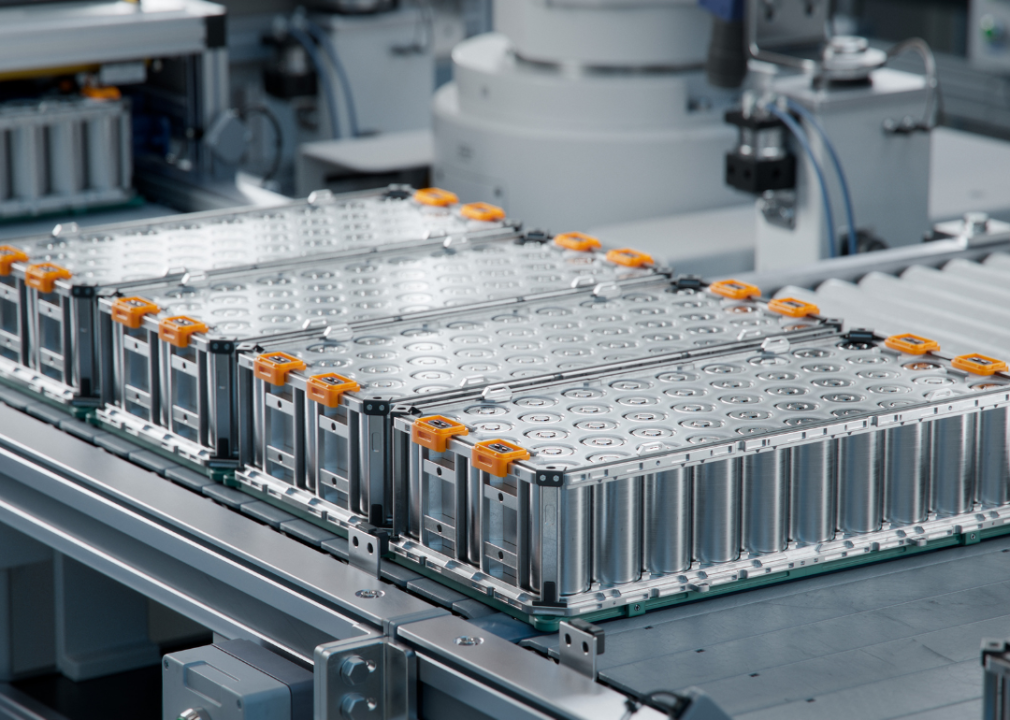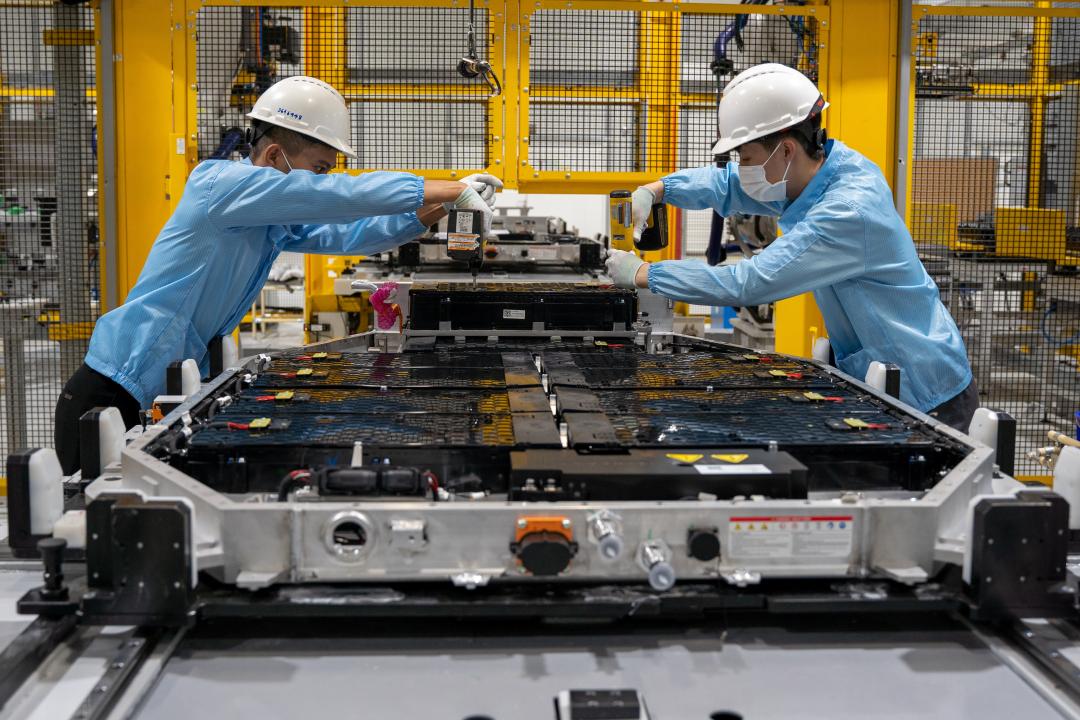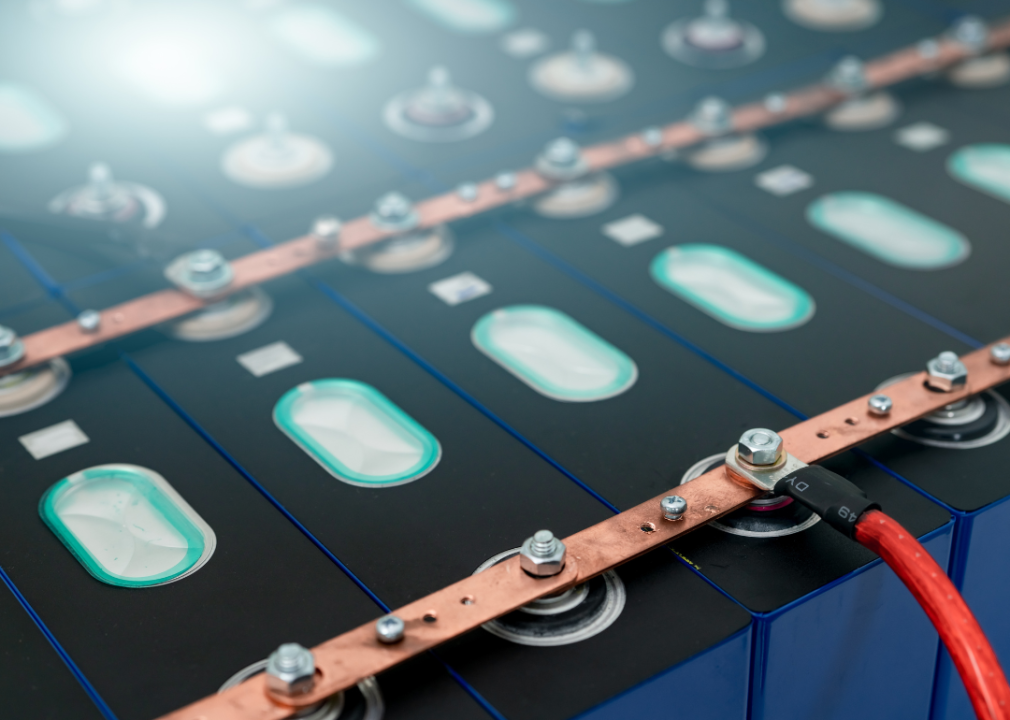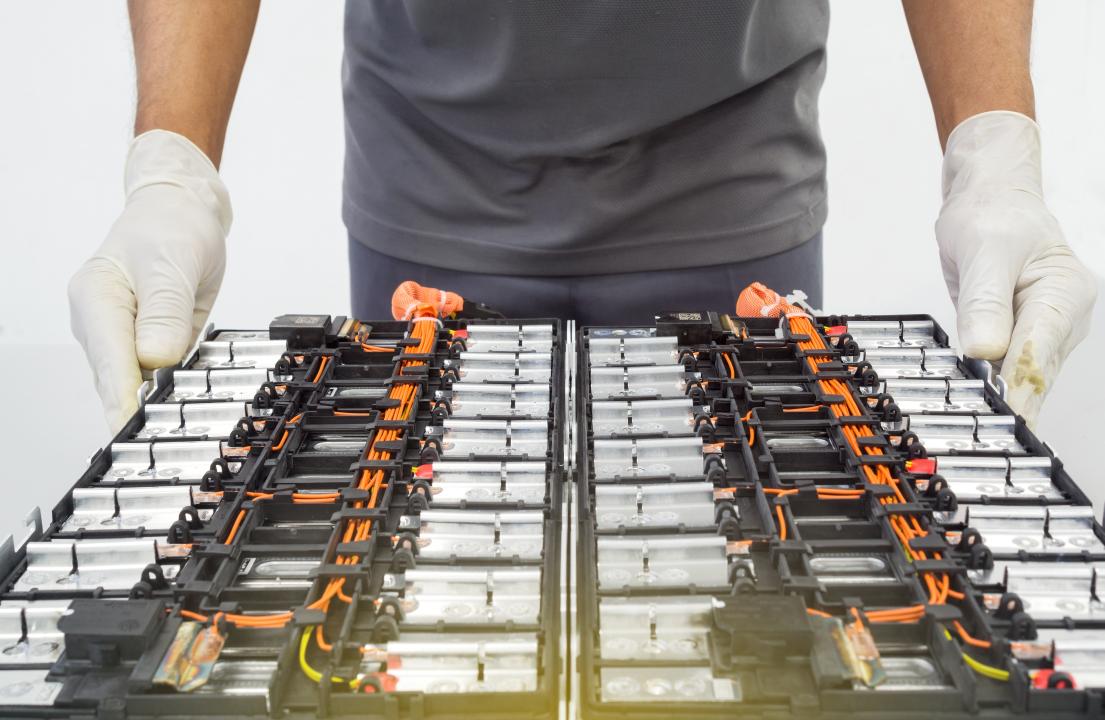How long do electric car batteries last, and can they eventually be repurposed and given a second life?

IM Imagery / Shutterstock
How long do electric car batteries last, and can they eventually be repurposed and given a second life?
Lithium-ion High-voltage Battery Component for Electric Vehicle or Hybrid Car. Battery Module for Automotive Industry on Production Line. High Capacity Battery Production inside a Factory.
Electric vehicle sales are booming. The International Energy Agency says more than 10 million EVs were sold worldwide in 2022, and their share of the overall car market rose from 4% in 2020 to 14% in 2022. The organization predicts more than half of the new cars sold in the U.S. will be electric by 2030. But what will happen to the millions of battery packs that power EVs once they are spent?
The answer is complicated. Unlike internal combustion engines that generally end up in scrapyards, EV batteries won’t be trashed there or in landfills. This Edmunds guide provides a comprehensive look at what governments and companies worldwide are planning to do with EV battery repurposing and EV battery recycling.
![]()

NamLong Nguyen / Shutterstock
What are electric car batteries and how long do they last?
Inside an electric vehicle battery pack shop at a VinFast factory in Haiphong, Vietnam on Saturday, Dec. 25, 2021.
EVs are powered by a lithium-ion battery pack that’s usually located in the floor of the vehicle. Lithium-ion batteries also power common electronic devices like laptops and cell phones. However, the ones that power EVs are much larger and heavier. They span most of the length of the EV, usually the area between the front and rear wheels. Current battery packs weigh about 1,000-2,000 pounds. They are called battery packs because they typically consist of several modules that, in some cases, can contain hundreds of individual lithium-ion cells.
EV battery packs are designed to last much longer than smaller lithium-ion batteries found in common electronics. Most experts put the range between 10 and 20 years. As a baseline, the federal government requires manufacturers to provide an eight-year/100,000-mile warranty. California’s requirement is longer: 10 years or 150,000 miles. It’s also reasonable to expect a battery to last longer than that. Tesla’s Impact Report for 2022, for example, states that its battery packs only have 12% degradation at 200,000 miles. When EV battery packs degrade about 30%, or provide 70% of their original capacity, they are no longer suitable for EVs. But they are still viable for years of a second-life application.
There are a few factors that affect the lifespan of EV battery packs. Heat is one of the biggest. Prolonged exposure to high temperatures causes batteries to degrade faster. Fortunately, EV battery packs have a battery management system that keeps temperatures in check. Frequent use of Level 3 fast-charging stations can also reduce battery life. Slower Level 1 and Level 2 charging is recommended to extend the battery pack’s life.

Fahroni / Shutterstock
Repurposing end-of-life EV battery packs for second-life use
Electric vehicle lithium NMC battery.
When a battery pack is no longer viable for use in an EV, it can be recycled (more on that later) or repurposed. The majority can be reused because they still have enough capacity for a second-life application. The Union of Concerned Scientists estimates that used EV battery packs have another five to eight years of life left in them for second-life applications. Since most EV battery packs are in their original vehicle, there currently aren’t enough for large-scale repurposing, but that won’t be the case for long. Several companies are already utilizing used EV battery packs, and Spiers New Technologies (SNT) is one of the largest and oldest.
SNT says it is a “one-stop solution for battery lifecycle management.” The Oklahoma-based company provides several services including the remanufacturing, repurposing, and recycling of used EV battery packs. They also offer analysis of used battery packs and logistics management, including storing battery packs for manufacturers. They receive battery packs from various automakers they work with or directly from dealerships. According to CNBC, since its start in 2014, SNT has “serviced more than 240,000 packs and more than 50,000 have been repaired, refurbished or remanufactured.” SNT told CNBC that 5-10% of the packs they receive are recycled, and that 80%-90% can be refurbished. The rest can be reused for second-life applications.
When EV battery packs aren’t remanufactured, they can be repurposed. Stationary power storage is a popular way companies repurpose used EV battery packs. It’s currently done on a small scale until more battery packs are ready to retire from EV use. RePurpose Energy is one of several companies taking advantage of used EV battery packs. This year the company plans to launch its product, which is a 20-foot shipping container packed with multiple EV battery packs that can store energy for commercial, industrial, and utility applications.
B2U Storage Solutions is another company that uses used EV battery packs for stationary energy storage. As with RePurpose Energy, B2U creates large containers that house multiple used EV battery packs. However, its patented EV Pack Storage system is already in use in a large-scale energy storage application at the company’s SEPV Sierra facility. It’s a solar field and battery storage facility located in California that uses 1,300 EV battery packs.
There are also companies repurposing used EV battery packs for residential use. Eco Stor, a Norwegian company, has developed a battery storage unit for homes that can store energy from solar panels to use during expensive peak hours of the day. Eco Stor says that its power storage unit can last 10 to 15 years. Used EV battery packs might also be used as energy storage for EV charging stations. According to MotorTrend, Volkswagen plans to use its end-of-life battery packs for energy storage at Electrify America charging stations. It will help offset the cost of using power from local utility companies during pricey peak hours.
Vehicle uses for refurbished battery packs
Refurbished battery packs can be reused as a replacement for a spent battery pack. For example, the InsideEVs website has reported on Nissan’s effort to offer refurbished Leaf battery packs for older models in Japan that need a replacement. In the U.S., third-party companies sell refurbished battery packs for Leafs and other EV models that have been on the road for a while such as Teslas and the BMW i3. Similarly, MotorTrend reported that Tesla can use refurbished battery packs for an out-of-warranty replacement to keep the cost lower.
Industrial and residential uses for refurbished battery packs
A neat second-life application for used EV battery packs is at the Johan Cruijff Arena in Amsterdam where 148 used Nissan Leaf battery packs are used for backup power and supplemental energy. The above examples are just some of the various ways in which used EV battery packs are being repurposed. When the capacity of used battery packs is depleted during their second-life application, they can be recycled to help make new EV battery packs.

Smile Fight / Shutterstock
Recycling EV batteries
Selective focus on the rubber-gloved hands of an expert technician holding a used Lithium-ion car battery before its repair
When EV battery packs can’t be refurbished or repurposed or have served their second-life application, it’s time to recycle them. As with repurposing, since most EV battery packs are still powering vehicles, recycling battery packs is done on a small scale for now. EV battery packs are very complex, and they contain various metals, a liquid electrolyte, circuitry, sensors and more. But what battery recyclers want are the metals, specifically lithium, cobalt, and nickel.
Those metals have considerable value and can be used to produce new EV batteries.
When EV batteries are manufactured, most of their metals are sourced from mining operations in foreign countries. In some cases, these countries have poor human rights records, or the mining operation negatively impacts the local environment. Reducing dependence on foreign countries is just one reason why the U.S. needs its own source of metals needed for EV battery production. Currently, battery recycling in North America doesn’t produce enough raw materials for EV battery production, but the hope is that it will in time.
In a Wired article, Alissa Kendall, a professor of civil and environmental engineering at the University of California, Davis, said, “Recycled materials could supply more than half of the cobalt, lithium, and nickel in new batteries by 2040, even as EVs get more popular.” If battery recycling provides a significant amount of the needed raw materials in the future, then it can also help reduce potential future supply shortages and help keep the price of raw materials from skyrocketing if there is a supply chain disruption.
There are other reasons why EV battery recycling is crucial. The Biden administration’s Inflation Reduction Act of 2022 encourages sourcing raw materials from the U.S. or from a country that has a free-trade agreement with the U.S. If automakers want their EVs to qualify for the tax credit, then a certain percentage of the rare earth metals in the battery packs must come from the U.S. or a free-trade country. And battery recycling companies are among automakers’ sources for the raw materials.
A more obvious reason is the need to keep battery packs out of landfills because they can leak hazardous materials into the ground and cause fires. The EPA states that lithium-ion batteries from small electronics caused more than 240 fires at 64 waste management facilities between 2013 and 2020.
EV battery recycling locations
According to Wired, most lithium-ion battery recycling is currently done in China, where 70% of lithium-ion batteries are made. However, the lithium-ion battery recycling industry is quickly growing in North America. Tesla’s former CTO, JB Straubel, founded Redwood Materials, one of North America’s largest lithium-ion battery recycling companies. According to Redwood Materials, the company will produce enough anode and cathode (components of battery cells) for 1 million EVs annually by 2025. The company says it recovered 1,268 battery packs from a one-year pilot program in California. Redwood Materials works with several automakers including Ford, Volvo, Volkswagen, and Toyota.
Li-Cycle, a Canadian lithium-ion battery recycling company, is another major player in the industry. The company says it currently has four recycling facilities in North America that can process 51,000 tons of lithium-ion battery materials a year. A new facility will open this year in New York, and the company has plans to expand to Europe. According to the New York governor’s office, Li-Cycle’s “spoke” facilities break down batteries into a black mass consisting of lithium, cobalt, and nickel. Then a “hub” facility will convert the black mass into battery-grade materials. Li-Cycle has partnered with many companies around the world including General Motors and LG Energy, one of the largest EV battery manufacturers in the world.
EV battery recycling methods
There are three methods of EV battery recycling. Pyrometallurgy is a common technique that melts the battery in a furnace to separate unwanted materials and extract valuable metals. It’s not a sustainable method because it’s energy-intensive and creates air pollution.
Hydrometallurgy is becoming increasingly popular. This method dissolves the batteries in acid, and the metals are then extracted using solvents. Hydrometallurgy is more environmentally friendly and can extract more raw materials than pyrometallurgy. Direct recycling is an emerging method that’s currently being done on a small scale. The battery is mechanically separated, but the wanted components aren’t destroyed and can be reused with less refining. This technique is the least energy-intensive and creates less pollution, but it needs to be improved for large-scale use.
In summary
While the production of raw materials that make EV battery packs isn’t environmentally sustainable yet, the result is a product that can be initially used for over 10 years in an EV, then potentially be put to use in a second-life application for several more years, then finally be recycled to make a new generation of batteries. That’s the goal, at least. Companies that repurpose and recycle EV batteries are still in their infancy, but as more EV batteries come to the end of their life, that won’t be the case anymore. According to Precedence Research, the EV battery recycling market is already worth about $2 billion, and it’s projected to be worth $19.3 billion by 2030. Transparency Market Research says the value of the EV battery repurposing or second-life industry is expected to reach $9.9 billion by 2031. EV battery recycling and repurposing are crucial to help make the future of transportation more sustainable.
This story was produced by Edmunds and reviewed and distributed by Stacker Media.